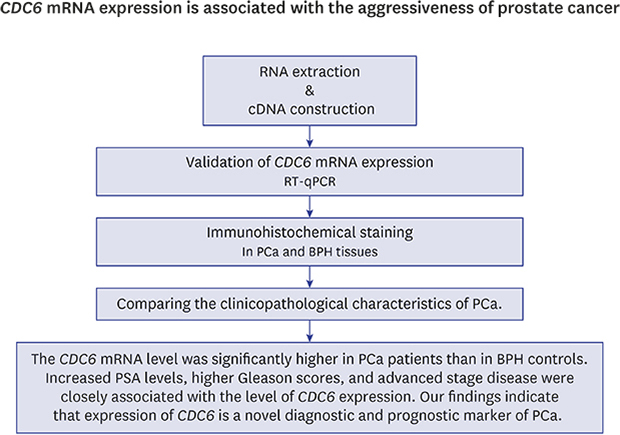1. Seo WI, Kang PM, Chung JI. Predictive value of the cancer of the prostate risk assessment score for recurrence-free survival after radical prostatectomy in Korea: a single-surgeon series. Korean J Urol. 2014; 55(5):321–326.

2. Kattan MW, Eastham JA, Stapleton AM, Wheeler TM, Scardino PT. A preoperative nomogram for disease recurrence following radical prostatectomy for prostate cancer. J Natl Cancer Inst. 1998; 90(10):766–771.

3. Partin AW, Kattan MW, Subong EN, Walsh PC, Wojno KJ, Oesterling JE, et al. Combination of prostate-specific antigen, clinical stage, and Gleason score to predict pathological stage of localized prostate cancer. A multi-institutional update. JAMA. 1997; 277(18):1445–1451.

4. Negrini S, Gorgoulis VG, Halazonetis TD. Genomic instability--an evolving hallmark of cancer. Nat Rev Mol Cell Biol. 2010; 11(3):220–228.
5. Charames GS, Bapat B. Genomic instability and cancer. Curr Mol Med. 2003; 3(7):589–596.

6. Romanowski P, Madine MA. Mechanisms restricting DNA replication to once per cell cycle: MCMs, pre-replicative complexes and kinases. Trends Cell Biol. 1996; 6(5):184–188.

7. Sasaki H, Kawano O, Endo K, Suzuki E, Yukiue H, Kobayashi Y, et al. Human MOB1 expression in non-small-cell lung cancer. Clin Lung Cancer. 2007; 8(4):273–276.

8. Borlado LR, Méndez J. CDC6: from DNA replication to cell cycle checkpoints and oncogenesis. Carcinogenesis. 2008; 29(2):237–243.

9. Hartwell LH. Sequential function of gene products relative to DNA synthesis in the yeast cell cycle. J Mol Biol. 1976; 104(4):803–817.

10. Hateboer G, Wobst A, Petersen BO, Le Cam L, Vigo E, Sardet C, et al. Cell cycle-regulated expression of mammalian CDC6 is dependent on E2F. Mol Cell Biol. 1998; 18(11):6679–6697.
11. Ohtani K, Tsujimoto A, Ikeda M, Nakamura M. Regulation of cell growth-dependent expression of mammalian CDC6 gene by the cell cycle transcription factor E2F. Oncogene. 1998; 17(14):1777–1785.

12. Yan Z, DeGregori J, Shohet R, Leone G, Stillman B, Nevins JR, et al. CDC6 is regulated by E2F and is essential for DNA replication in mammalian cells. Proc Natl hAcad Sci U S A. 1998; 95(7):3603–3608.

13. Ohta S, Koide M, Tokuyama T, Yokota N, Nishizawa S, Namba H. CDC6 expression as a marker of proliferative activity in brain tumors. Oncol Rep. 2001; 8(5):1063–1066.
14. Xiong XD, Fang JH, Qiu FE, Zhao J, Cheng J, Yuan Y, et al. A novel functional polymorphism in the CDC6 promoter is associated with the risk for hepatocellular carcinoma. Mutat Res. 2008; 643(1-2):70–74.

15. Zhang X, Xiao D, Wang Z, Zou Y, Huang L, Lin W, et al. MicroRNA-26a/b regulate DNA replication licensing, tumorigenesis, and prognosis by targeting CDC6 in lung cancer. Mol Cancer Res. 2014; 12(11):1535–1546.
16. Deng Y, Jiang L, Wang Y, Xi Q, Zhong J, Liu J, et al. High expression of CDC6 is associated with accelerated cell proliferation and poor prognosis of epithelial ovarian cancer. Pathol Res Pract. 2016; 212(4):239–246.
17. Sun TY, Xie HJ, He H, Li Z, Kong LF. miR-26a inhibits the proliferation of ovarian cancer cells via regulating CDC6 expression. Am J Transl Res. 2016; 8(2):1037–1046.
18. Liu Y, Gong Z, Sun L, Li X. FOXM1 and androgen receptor co-regulate CDC6 gene transcription and DNA replication in prostate cancer cells. Biochim Biophys Acta. 2014; 1839(4):297–305.

19. Williams RS, Shohet RV, Stillman B. A human protein related to yeast Cdc6p. Proc Natl Acad Sci U S A. 1997; 94(1):142–147.

20. Niimi S, Arakawa-Takeuchi S, Uranbileg B, Park JH, Jinno S, Okayama H. CDC6 protein obstructs apoptosome assembly and consequent cell death by forming stable complexes with activated Apaf-1 molecules. J Biol Chem. 2012; 287(22):18573–18583.

21. Piatti S, Lengauer C, Nasmyth K. CDC6 is an unstable protein whose de novo synthesis in G1 is important for the onset of S phase and for preventing a ‘reductional’ anaphase in the budding yeast Saccharomyces cerevisiae. EMBO J. 1995; 14(15):3788–3799.

22. Feng CJ, Lu XW, Luo DY, Li HJ, Guo JB. Knockdown of CDC6 inhibits proliferation of tongue squamous cell carcinoma Tca8113 cells. Technol Cancer Res Treat. 2013; 12(2):173–181.

23. Jin F, Fondell JD. A novel androgen receptor-binding element modulates CDC6 transcription in prostate cancer cells during cell-cycle progression. Nucleic Acids Res. 2009; 37(14):4826–4838.

24. Xiong XD, Zeng LQ, Xiong QY, Lu SX, Zhang ZZ, Luo XP, et al. Association between the CDC6 G1321A polymorphism and the risk of cervical cancer. Int J Gynecol Cancer. 2010; 20(5):856–861.

25. Martin CM, Astbury K, McEvoy L, O'Toole S, Sheils O, O'Leary JJ. Gene expression profiling in cervical cancer: identification of novel markers for disease diagnosis and therapy. Methods Mol Biol. 2009; 511:333–359.

26. Feng CJ, Li HJ, Li JN, Lu YJ, Liao GQ. Expression of Mcm7 and CDC6 in oral squamous cell carcinoma and precancerous lesions. Anticancer Res. 2008; 28(6A):3763–3769.
27. Makarov DV, Sanderson H, Partin AW, Epstein JI. Gleason score 7 prostate cancer on needle biopsy: is the prognostic difference in Gleason scores 4 + 3 and 3 + 4 independent of the number of involved cores? J Urol. 2002; 167(6):2440–2442.
28. Kang HW, Jung HD, Lee JY, Kwon JK, Jeh SU, Cho KS, et al. The Within-Group Discrimination Ability of the Cancer of the Prostate Risk Assessment Score for Men with Intermediate-Risk Prostate Cancer. J Korean Med Sci. 2018; 33(5):e36.

29. Ruckle HC, Klee GG, Oesterling JE. Prostate-specific antigen: concepts for staging prostate cancer and monitoring response to therapy. Mayo Clin Proc. 1994; 69(1):69–79.










 PDF
PDF Citation
Citation Print
Print






 XML Download
XML Download